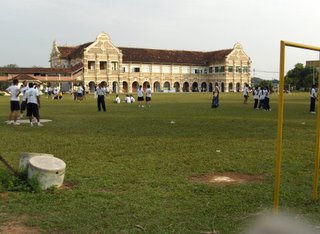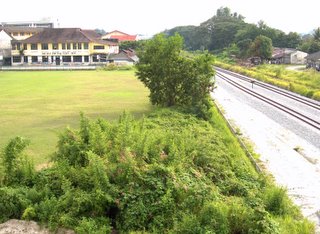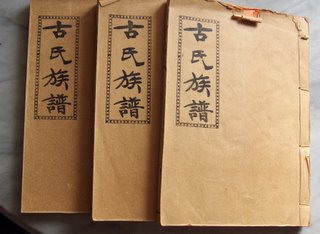
My Alma Mater , as it was just next to the bus terminal, I dropped in for a visit on arriving in Ipoh. There is a side entrance to the school from Kidd Road, while the main entrance faces Lahat Road. This main building build in Edwardian style of the era, was ‘ erected to the Glory of God and for the advancement in knowledge of the youth of Perak’. The foundation stone was laid by Oliver Marks Esq. acting British Resident Perak on August 1st 1912, and opened on March 30th, 1914 by Sir Arthur Young. The builder and architect was CH La Brooy.
The school celebrated its 110 anniversary last year, 2005. It was founded by the Rev. Horley as a Methodist Institution in the new mining township upcountry of Epoh. During school Sports Day the students are divided into five competing teams, namely Horley, Oldham, Aziz, Tagore, Eu Tong Sen. Horley is in memory of the founder of the school in Ipoh, while Oldham was in memory of Rev William F Oldham, the founder of the Anglo-Chinese School, Singapore in 1886, where it was first located at 70 Amoy Street.

Behind the school is the railway track . The railway runs thro the Peninsula, south to KL-Singapore, and North to Penang-Bangkok, and in future possibly to Hanoi and then to China as part of the trans-Asean-China track. The railway line is under construction to a double carriage track. The work has been going on for some years. We used to see the train passing by in the moring and evening having our PE classes in the field. The building in the background is the school hostel.

These Tembusu tress that lined the side of the field facing the road leading to the primary building, must be as old as the school. These trees were considered old when I first entered the school. I could remember the trees well because when I was in Standard Three, we used to play police and thieves there among the trees while waiting for the afternoon class to start.
The buildings in the school have not changed much over the years and since I left 30 years ago. They looked a little worn & weather beaten though, and now with a heavy fence around the school perimeter, the buildings and fields seem caged in, and it did not seem to be the open and spacious school compound that I used to remember.

This wooden building is the original site of the school where it first began. It is now possibly the oldest wooden school building in Ipoh. My Standard One class room was on the upper floor towards the left of the building. The photograph below was the class of Std IC taken in 1964. (I found it among the old albums in the study). The class teacher was Mrs Cheah Chan Yew, and the Senior Assistant, Mr Foo Choy Wan, was also a very strict, fierce but kind-at-heart discipline master. It was a big class of 50 pupils.

The class of pupils had a good ethic mix and the boys study, play and 'f'ight' together amongst themselves. The Malay boys came from Kampong Paloh nearby, the Indian and Sikh pupuils from Buntong, and the Chinese from the town and township nearby.
This is the model for the Vision School that the Malaysian government is promoting. I certainly have learnt cultural diversity and ethic harmony in my formative years, thanks to my fellow pupils. I recall that the first Prime Minister of Malaysia, the Tengku used to mention that he was the proudest and happiest PM in the world cos his countrymen lived in ethnic harmony and peace.
/--
 This building in Ipoh Old Town built in 1907 is the Eu Yan Sang (余仁生) Chinese medical hall. It has been dispensing TCM (Traditional Chinese Medicine) to the folks in Ipoh for the past century. It is located in the old town sector of Ipoh which used to a very busy area and the premier shopping district in town. It is the hall mark of EYS to have it’s shops set up in shopping center of the town.
This building in Ipoh Old Town built in 1907 is the Eu Yan Sang (余仁生) Chinese medical hall. It has been dispensing TCM (Traditional Chinese Medicine) to the folks in Ipoh for the past century. It is located in the old town sector of Ipoh which used to a very busy area and the premier shopping district in town. It is the hall mark of EYS to have it’s shops set up in shopping center of the town. The EYS Medical Hall in Singapore opened in 1910. It is located along South Bridge Road, and was renovated a few yesars back. It is possibly the only building along that stretch of road that is still engaging in the original trade it was set up for. TCM is back in business and still going strong.
The EYS Medical Hall in Singapore opened in 1910. It is located along South Bridge Road, and was renovated a few yesars back. It is possibly the only building along that stretch of road that is still engaging in the original trade it was set up for. TCM is back in business and still going strong.


 old charm that never fades - one of the side lanes in old town sector
old charm that never fades - one of the side lanes in old town sector





 My Alma Mater , as it was just next to the bus terminal, I dropped in for a visit on arriving in Ipoh. There is a side entrance to the school from Kidd Road, while the main entrance faces Lahat Road. This main building build in Edwardian style of the era, was ‘ erected to the Glory of God and for the advancement in knowledge of the youth of Perak’. The foundation stone was laid by Oliver Marks Esq. acting British Resident Perak on August 1st 1912, and opened on March 30th, 1914 by Sir Arthur Young. The builder and architect was CH La Brooy.
My Alma Mater , as it was just next to the bus terminal, I dropped in for a visit on arriving in Ipoh. There is a side entrance to the school from Kidd Road, while the main entrance faces Lahat Road. This main building build in Edwardian style of the era, was ‘ erected to the Glory of God and for the advancement in knowledge of the youth of Perak’. The foundation stone was laid by Oliver Marks Esq. acting British Resident Perak on August 1st 1912, and opened on March 30th, 1914 by Sir Arthur Young. The builder and architect was CH La Brooy.











